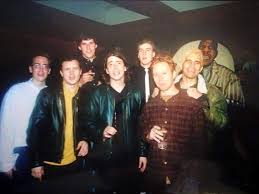Third time was the charm for U2. The Irish lads raised their profile from “one of many interesting new wave bands from the British Isles” to “the band to pay attention to from across the ocean” with their third album, War, released this day in 1983.
U2 had drawn attention globally with their first couple of albums, the impressive debut Boy in 1980 and the *cough*not-so-memorable*cough* sophomore effort October in ’81. But to this point they were mixed in with bands like Big Country and The Alarm, and Simple Minds who in all likelihood at that point were considered the biggest “post-punk” act going. War certainly changed all that and pointed to the world-conquering, larger-than-life band they were on the road to becoming. At a time when bands like Kajagoogoo and Spandau Ballet were on the cutting edge of music coming out of Britain and Ireland, U2 stood out like a thunderstorm on a spring afternoon. Not only did the Edge deliver solid, chunky, rockin‘ guitars, the band’s lyrics were anything but sunshine and lollipops. The brilliant “Sunday Bloody Sunday” dealt with the Bogside Massacre in Ireland; the lead single, “New Year’s Day” was loosely-inspired by the Polish Solidarity movement and the first signs of the crumbling of the Iron Curtain. “40”, an album cut which has become one of the band’s most popular in concert is inspired by the Old Testament’s Psalm 40, which among other things asks God “Let them be ashamed and confounded together, that seek after my soul to destroy it and let them be driven backward.”
The reason for the darkish turn, and album title, was explained that year by Bono: “Everywhere you looked from the Falklands to the Middle East to South Africa, there was war…we’re not only interested in the physical aspects of war,” he continued, “The emotional effects are just as important: ‘the trenches dug within our hearts…”
At the time the British press wasn’t all that enthusiastic. The NME panned it, for instance, saying “where Boy shone and flowed, War is dull and static.” Over here, the critics were kinder. The Village Voice gave it a B+ and Rolling Stone gave it 4-stars, saying that while the first two albums sounded OK, they were lightweight. “October wrapped itself in romance and religion but didn’t understand either,” it noted, but “War makes for impressive listening but more important it deals with a difficult subject in a sensible way.” It also applauded the singer – then still known as Bono Vox, and the Edge’s guitar which “demonstrates (U2) can play hard rock with the best.” The magazine has since ranked it among the top half of the 500 greatest albums of all-time.
Regardless of the critics, pro or con, the public ate it up. It was their first #1 album in the UK, first to crack the top 20 in the US and first one to make the charts at all in Germany. It’s worldwide sales of 11 million were more than the prior 2 records put together and would be among the best tallies of the decade… but as we now know, not even close to what the band would do a few years later with The Joshua Tree.











